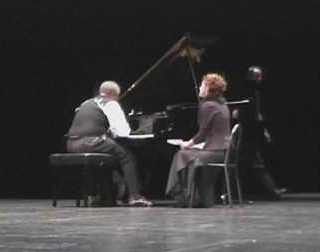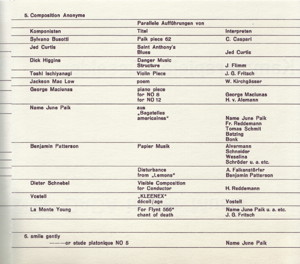> Studies > FAC-SIMILES > La Monte Young
early works of "noise" music / œuvres racines de la musique noise : — Studies —
NOISEseconde étude / Study 2X FOR HENRY FLYNT [OR ARABIC NUMERAL (ANY INTEGER)] (1960) |
|
Articles connexes / Other related articles : • LA MONTE YOUNG (Papers, articles) — read /lire • LA MONTE YOUNG (Works) — read /lire • LA MONTE YOUNG (Scores, writings) — read /lire • LA MONTE YOUNG (Interview 2003) — read /lire • THE WELL-TUNED PIANO (La Monte Young) — read /lire • BB DORIAN BLUES - TREE - YAM FESTIVAL (La Monte Young) — read /lire • DREAM HOUSE, ETC (La Monte Young) — bientôt / soon • Around La Monte Young : FLYNT, MACIUNAS — read /lire • LA MONTE YOUNG — An Anthology of Chance Operations (1963) — read /lire • LA MONTE YOUNG — Selected Writings (1959-1969) — read /lire |
Cette série explore les œuvres racines de la musique "noise" / This series is a study about early works of "noise" music. • RAINFOREST (David Tudor) - 1968-1973 — read /lire • BANDONEON (David Tudor) - 1966 • POEM FOR CHAIRS, TABLES, BENCHES, ETC (La Monte Young) - 1960 — read /lire • X FOR HENRY FLYNT (La Monte Young) - 1960 — read /lire •TWO SOUNDS (La Monte Young) - 1960 — read /lire • MUSIQUE BAROQUE - CONTREMUSIQUE, MACHINERIES ET SON/BRUIT - XVIIIeme siècle / BAROQUE MUSIC / COUNTER-MUSIC / ROUGH MUSIC / MACHINERIES AND NOISE — read /lire • ŒUVRES DE CHRISTIAN WOLFF - Faits, Actions, Collectifs — read /lire • STONES & STICKS (Christian Wolff) - 1971 — read /lire • MUSIQUES À INTENSITÉs (ETHNOMUSICOLOGIE) / MUSIC WITH LOUDNESS — (ETHNOMUSICOLOGY, POPULAR & FOLK MUSIC STUDIES) — read /lire • DRONES (Yoshi Wada) — read /lire • THE WOLFMAN (Robert Ashley) — read /lire |
X for Henry Flynt (1960)(Edit)
arabic numeral (any integer) — [ou X (any integer)]
1960, Arabic Numeral (tout nombre entier) to H. F., pour piano(s), ou gong(s) ou ensembles of ensemble d'au moins 45 instruments d'un même timbre, ou leurs combinaisons, ou orchestre.
Pour cette œuvre, la seule instruction laissée à l'interprète est de produire un son très fort un nombre X de fois, répété toutes les une ou deux secondes, aussi uniformément et régulièrement que possible, sans que la durée totale de l'œuvre soit spécifiée.
La présomption a toujours été que l'instrumentation n'est pas consignée. Toutefois la partition indique "pour piano ou pour gong joué avec une baguette de percussion". En examinant la liste des œuvres de La Monte Young, nous remarquons qu'il est noté :
| pour piano(s) ou gong(s) or ensemble(s) comprenant au moins 45 instruments du même timbre, ou toute combinaison possible à partir de ces propositions, ou orchestre. Au cours des dernières années, La Monte Young a supervisé la plupart des performances de cette œuvre interprétée par différents groupes ou ensembles. [Young and Zazeela, email, 17 juin 2004]— (Cité dans Dave Smith, "Following a Straight Line: La Monte Young", Originally published in Contact no. 18 (Winter 1977-78), pp. 4-9. |
Extrait audio
|
FORTY-TWO FOR HENRY FLYNT, for gong solo, Performed by Peter Winkler (gong) at the Third Annual Festival of the Avant Garde in San Francisco, 1965 Source : http://archive.org/details/42forHenryFlynt |
Premières représentations :
La pièce a été écrite pour le pianiste Leonard Stein, professeur de La Monte Young à l'Université de Berkeley, lequel avait demandé à son élève une composition pour sa tournée européenne. Stein a laissé la pièce de côté et l'a remisée, et c'est le premier mari de Yoko Ono, le compositeur expérimental Toshi Ichiyanagi, qui l'a donnée en première mondiale lors de la série Chambers Street au Carnegie Hall en 1961. Cornelius Cardew l'a donnée en création française à Paris le mois suivant, et John Cale a été l'interprète de la création britannique de l'œuvre en 1963 [(ou 1964)].
| Ichiyanagi a choisi le nombre 566 pour la création de l'œuvre à New York, tandis que Cornelius Cardew lors de la création à Paris choisissait 1698. La Monte Young de son côté fît la différence en quelque sorte en prenant 923 comme nombre de répétitions à effectuer lors de son interprétation lors du ONCE Festival à Ann Arbor dans le Michigan au mois de février 1962 (David Tudor l'a joué aussi lors de ce même mois de février) — (Cité par Branden W. Joseph, "Andy Warhol's Sleep : The Play of Repetition", In "Masterpieces of Modernist Cinema", Edited by Ted Perry, Bloomington IN : Indiana University Press, 2006) |
| English version — "Ichiyanagi selected the number 566 for its New York premiere, while Cornelius Cardew, performing new month in Paris, chose 1698. La Monte Young himself somewhat split the difference, clocking in at 923 repetitions at the ONCE Festival in Ann Arbor, Michigan in February 1962 (David Tudor performed it that same February)" — (Quotation by Branden W. Joseph, "Andy Warhol's Sleep : The Play of Repetition", In "Masterpieces of Modernist Cinema", Edited by Ted Perry, Bloomington IN : Indiana University Press, 2006) |
Propos de John Cale à propos de “X for Henry Flynt” :
(voir plus bas, performance le 6 juil. 1964)
| In 1962, I was at Goldsmiths [College]. I was really wrapped up in writing pieces that were instructions. That’s when I found La Monte Young, and Cage, and “4’33″”, which threw another spanner in the works, because it was really about how environment impacts performance. This is a peculiar American thing that was very fractured, because in Europe, the concert was sacrosanct : silence, and you listen. But you don’t listen to Cage as much as you read him. If you read him in "Silence", or "A Year From Monday", you get a world outlook that’s very interesting. The walls of the concert hall were not the only thing that he was breaking down. We learned about discipline and working every day from La Monte, about not particularly forcing anything to happen, but allowing things to happen. I think Cage liked how La Monte was writing instructions for performers. That’s the original performance art. And those instructions didn’t just deal with performance or music. “X for Henry Flynt” was a piece where you pick an event and then you repeat it X number of times with the same gap in time between it. “Draw a straight line and follow it,” which was really about Einstein and space. If you draw a straight line and you come back to where you started, then space is finite. So you really didn’t know what’s performance and what’s not. Later, when La Monte and I were working together down here on Church Street, holding the drum for an hour and a half every day for a year and a half, it’s like, “What is a performance ? Where does it start and where does it end ?” And his idea was that it didn’t. He said it was a very Chinese idea at the time. Everybody else in Europe think about centuries. But China thinks in terms of eons. |
| "X for Henry Flint" (1960) shows Young's predilection to limit the musical work to a single object or event (as compared with Cage's emphasis on multiplicity). "X for Henry Flint" eschews traditional classical music's discourse of contrasting materials in favour of the prolonged repetition of a single sound. The performance directions to the piece dictate that a pianist should repeat a single loud cluster, using the forearms, in a uniform manner and for a long time. Keith Potter has observed that 'the longer a note is sustained, the more its overtones become clear.' (Potter 2000: 64) Sheer familiarity with the repeated cluster on the part of the listener results in the gradual foregrounding of its overtones. The interest of the piece therefore inheres not in the perceived repetition of an identical object, but in the fact that repetition evinces the play of difference beneath the surface, the differential subsurface. Subtle, unintentional changes of balance, dynamic, duration or pitch content between the various iterations lend an entirely different perspective to the 'same' sound event. [...] Young's worklist for "X for Henry Flint" leaves the choice of instrumentation remarkably open. It specifies that 'piano(s) or gong(s) or ensembles of at least forty-five instruments of the same timbre, or combinations of the above, or orchestra' may perform the piece. [...] Thus, Young renounces subjective choice to a high degree. There are no expectations raised in "X for Henry Flint", as it is undialectical and holistic in approach. To a certain extent, Young could be seen to bypass the expressive subject altogether. — (Heatlicote, Abigail (2003). "Liberating sounds: philosophical perspectives on the music and writings of Helmut Lachenmann", Durham theses, Durham University, pp. 239-240 — Available at Durham E-Theses Online: http://etheses.dur.ac.uk/4059/ |
Cornelius Cardew note que l'intérêt de cette œuvre réside dans :
- Sa durée, et proportionnellement à cela :
- les variations au sein de la répétition uniforme.
- la contrainte imposée à l'interprète soliste et à travers lui au public.
Ces éléments apparaissent et émergent au-delà des instructions de l'œuvre (sa partition), bien que, naturellement, ils en résultent. Ce que l'auditeur peut entendre et apprécier sont les erreurs dans l'interprétation. Si la pièce était réalisée par une machine, l'intérêt disparaîtrait et avec lui la composition même.
— Cornelius Cardew, '"On the role of the instructions in the interpretation of indeterminate music'', Treatise Handbook (London, etc.: Peters, 1971), p. XIV.
Voir aussi : Cornelius Cardew, 'One Sound: La Monte Young', The Musical Times, Vol.107, No. 1485 (November 1966) p.959.
| English version — (1) Its duration, and proportional to that : (2) the variation within the uniform repetition. (3) the stress imposed on the single performer and through him on the audience... These elements occur rather in spite of the instructions, although naturally they are the result of them. What the listener can hear and appreciate are the errors in the interpretation. If the piece were performed by a machine this interest would disappear and with it the composition. — Cornelius Cardew, 'On the role of the instructions in the interpretation of indeterminate music', Treatise Handbook (London, etc.: Peters, 1971), p. XIV. |
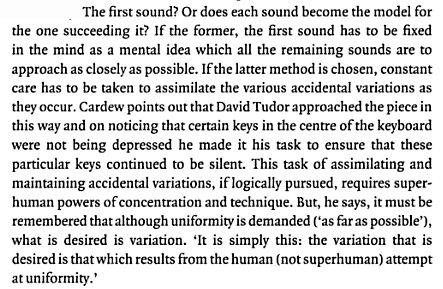 | COMMENTAIRES À PROPOS DE CARDEW ET LA MONTE YOUNG SUR "X FOR HENRY FLYNT" TIRÉ DE "EXPERIMENTAL MUSIC : CAGE AND BEYOND" PAR MICHAEL NYMAN "LA PERSPICACE PRÉOCCUPATION DE CARDEW FACE AUX IMPLICATIONS DES MOTS "QUE POSSIBLE" APPLIQUÉS À "UNIFORMITÉ ET RÉGULARITÉ" DANS "X FOR HENRY FLYNT" DE LA MONTE YOUNG — UNE PIÈCE NON ÉCRITE DU DÉBUT DES ANNÉES SOIXANTE DANS LAQUELLE UN SON PUISSANT (UN "CLUSTER", PAR EXEMPLE) DOIT ÊTRE RÉPÉTÉ AUSSI UNIFORMÉMENT, AUSSI RÉGULIÈREMENT QUE POSSIBLE UN NOMBRE RELATIVEMENT IMPORTANT DE FOIS — TÉMOIGNE DE SA CONSCIENCE DE LA NATURE DU PROBLÈME (TOUT COMME CE QU'IL EXIGE INDIVIDUELLEMENT DE CHAQUE EXÉCUTANT DANS SON "SCHOOLTIME SPECIAL" FOURNIT UN ANTIDOTE PUISSANT ET PROGRAMMÉ AU JEU AUTOMATIQUE OU DÉSINVOLTE DANS TOUT AUTRE SITUATION). IL S'INTERROGE SUR CE QUI SERT DE MODÈLE Á L'UNIFORMITÉ. EST-CE LE PREMIER SON ? OU ALORS CHAQUE SON DEVIENT-IL LE MODÈLE DE CELUI QUI LUI SUCCÈDE ? DANS LE CAS INITIAL, LE PREMIER SON DOIT RESTER GRAVÉ DANS L'ESPRIT EN TANT QU'IDÉE MENTALE DONT DOIVENT SE RAPPROCHER AUTANT QUE POSSIBLE LES SONS RESTANTS. SI ON CHOISIT LA SECONDE MÉTHODE, IL FAUT PRÊTER UNE ATTENTION DE TOUS LES INSTANTS AFIN D'ASSIMILER LES DIVERSES VARIATIONS ACCIDENTELLES AU MOMENT OÚ ELLES SURVIENNENT. CARDEW SOULIGNE QUE C'EST DE CETTE MANIÈRE QUE DAVID TUDOR ABORDAIT LA PIÈCE ET QU'APRÈS AVOIR REMARQUÉ QUE CERTAINES TOUCHES AU CENTRE DU CLAVIER N'ÉTAIENT PAS ENFONCÉES IL SE FIT UN DEVOIR DE S'ASSURER QUE CES TOUCHES PRÉCISES RESTENT SILENCIEUSES. CETTE TÂCHE D'ASSIMILER ET D'ENTRETENIR LES VARIATIONS ACCIDENTELLES, SI ELLE EST MENÉE LOGIQUEMENT, EXIGE DES POUVOIRS DE CONCENTRATION ET DE TECHNICITÉ SURHUMAINS. MAIS, DIT-IL, IL FAUT SE SOUVENIR QU'ALORS L'UNIFORMITÉ ("LA PLUS GRANDE POSSIBLE") EST RÉCLAMÉE, CE QUI EST DÉSIRÉ EST LA VARIATION. "C'EST SIMPLE : LA VARIATION DÉSIRÉE EST CE QUI RÉSULTE DE LA TENTATIVE HUMAINE (ET NON SURHUMAINE) D'UNIFORMITÉ". |
 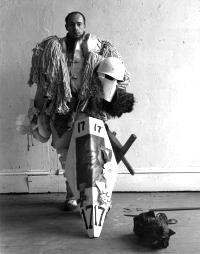 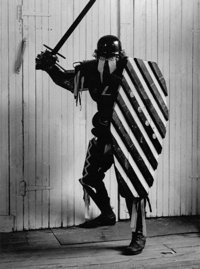 ROBERT MORRIS & ROBERT HUOT EN COSTUMES POUR "WAR". 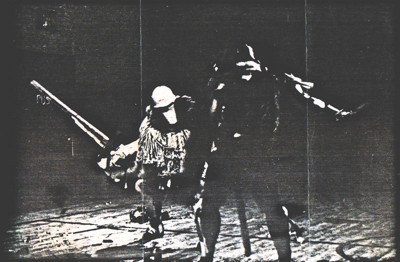 | COMMENTAIRE SUR "X FOR HENRY FLYNT" JOUÉ LORS DE LA CHORÉGRAPHIE "WAR" DE ROBERT MORRIS ET ROBERT HUOT, 30 JANVIER 1963, JUDSON THEATER. "I knew Mark di Suvero from having worked in a small studio below him near the old Fulton Fish Market before moving to my loft on Church Street, and I asked him to make me a steel gong. He cut a four-foot circle from a plate of steel with his cutting torch. The heat caused the circle to deform slightly into a concave/convex shape, which seemed perfect for a gong. I made a large wooden frame in which to hang the gong and asked La Monte Young to “play” this instrument for the combat-performance. We performed "War" on January 30, 1963, and it was my first involvement with the Judson. We never rehearsed "War". It started with La Monte just hitting the gong for fifteen minutes in pitch-dark in the gym. Then the lights went up with Huot at one end and myself at the other. We began running toward each other and we slammed into each other with our shields. We were each holding a pigeon. I had bought the birds, after first trying to trap some in Washington Square Park. When we hit we let them go and they flew into the audience. The piece consisted of us hitting each other with fake swords and maces until all was demolished. Then the lights went out. I gave the gong to La Monte. Six months later he called; he wanted me to listen to a recording he had made with it. He had wired it with contact microphones and played it with a bow." (Robert Morris, on "War", ArtForum, 06.08.12) "Je connaissais Mark di Suvero car nous étions voisins dans le vieux Old Fulton Fish Market avant que je n'habite sur Church Street, et je lui avais demandé de me fabriquer un gong. Il a fabriqué un cercle de près d'1m20 à partir d'une plaque d'acier avec son chalumeau. La chaleur a tordu le cercle de manière concave et convexe, ce qui semblait parfait pour un gong. J'ai fabriqué un cadre en bois pour suspendre le gong et j'ai demandé à La Monte Young de "jouer" cet instrument lors de notre "performance-combat". Nous avons joué "War" le 30 janvier 1963 et c'était ma première activité au sein du Judson Workshop. Nous n'avions jamais répété "War". Cela débutait par la musique avec La Monte Young qui frappait un gong pendant une quinzaine de minutes dans l'obscurité totale du gymnase. Ensuite les lumières s'allumaient quand Robert Huot apparut d'un côté et moi de l'autre. Nous avons commencé en courant l'un après l'autre et nous nous frappions avec nos boucliers. Nous portions chacun un pigeon. J'avais acheté les oiseaux après avoir essayé d'en attraper sans succès au Washington Square Park. Lors de notre combat nous les avons laissé partir et ils se sont envolés vers le public. La performance consistait à se battre avec des épées et des masses factices jusqu'à ce que ces derniers soient inutilisables et détruits. Ensuite les lumières s'éteignaient. J'avais donné le gong à La Monte. Six mois plus tard il m'a rappelé ; il voulait me faire écouter l'enregistrement qu'il avait fait avec ce gong. Il l'avait appareillé avec des microphones de contact et il jouait sur le gong avec un archet." — (Robert Morris, à propos de "War", ArtForum, 06.08.12) à propos de Robert Morris, continuez la lecture / Concerning Robert Morris, continue reading (Ryan & Joy scenarios) |
"X for Henry Flynt" a eu une influence importante sur les musiciens du Scratch Orchestra (comme on peut le remarquer dans les commentaires ci-dessus de Cornelius Cardew). Pour le Scratch Orchestra, un des "statements" est [qu']il est seulement nécessaire de spécifier une procédure, et la variété vient de la façon dont tout le monde fait les choses différemment — Michael Parsons, selon la citation in Michael Nyman, 'Believe it or not melody rides again', Music and Musicians, Vol. 20, No. 2 (October 1971), p. 28. — Voir aussi l'article, qui se montre plus critique, de John Tilbury, "The Experimental Years : A View From the Left", In Contact n°22, Summer 1981, pp. 16-21 — http://www.experimentalmusic.co.uk/emc/Jems_files/Tilburyleft.pdf .
Les principes et l'éthique de l'œuvre "X for Henry Flynt" étendus et appliqués aux performances par un groupe ou un ensemble amateur ont été une mesure radicale initiée par Cardew dans "The Great Learning" (1968-1970). On peut citer d'autres exemples dont :
- "Mindfulness of Breathing" (1969) de Michael Parsons, une œuvre "drone" chantée, faiblement et suffisamment lentement par des voix de basse (low and suitably slow)
- "Drum No. 1" (1969) d'Howard Skempton qui est jouée souvent sur des durées longues et dont le résultat est toujours fascinant : nombre indéterminé de percussions (caisses). Introduction de la pulsation. Continuité de la pulsation. Variations par emphases, décorations, contradictions (Any number of drums. Introduction of the pulse. Continuation of the pulse. Deviation through emphasis, decoration, contradiction.)
— (Dave Smith, "Following a Straight Line: La Monte Young", Originally published in Contact no. 18 (Winter 1977-78), pp. 4-9.
 | TIRÉ DE "DRAW A STRAIGHT LINE AND FOLLOW IT : THE MUSIC AND MYSTICISM OF LA MONTE YOUNG", PAR JEREMY GRIMSHAW Addendum by La Monte Young : http://drawastraightlineandfollowit.com/ 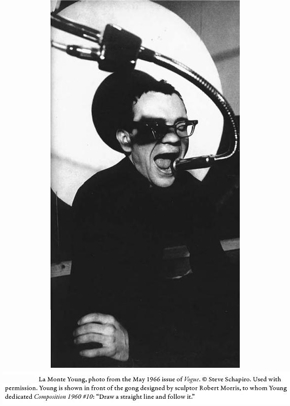 |
Exemples de performances de X for Henry Flynt :
- monter sur scène pour frapper une poêle à frire avec une cuillère en bois 600 fois sans arrêt.
[Interprétation de La Monte Young] - souvent réalisée en jouant des clusters avec les avant-bras sur le clavier d'un piano.
[Brian Eno interpréta "X for Henry Flynt" au Trent Polytechnic en 1974, en jouant des clusters 3600 fois avec les avant-bras sur le clavier du piano en essayant d'effectuer le même cluster à chaque impact. — "But after ten minutes, it became progressively more absorbing. This was reflected in the rate at which people left the room — those who didn't leave within ten minutes stayed for the whole performance. One began to notice the most minute variations from one crash to the next. The substraction of one note by the right elbow missing its top key was immediately and dramatically obvious. The slight variations of timing became major compositional changes, and the constant changes within the odd beat frequencies being formed by all the discords began to develop into melodic lines. This was, for me, a new use of the error principle and led me to codify a little law that has since informed much of much of my work — "Repetition is a form of change" —"] - en utilisant un marteau dans un récipient appareillé d'un microphone de contact et dans lequel des rognures d'ongles sont déposées ("by driving a hammer into a bucketful of nails amplified with a contact microphone") (Cité dans "Music, Electronic Media, and Culture" de Simon Emmerson)
| According to the composer and Marian Zazeela, 'The hammer and nails version is totally unknown to us, although it could be a misreference to the bucket of triangles stirred with a drumstick that was used to make a recorded sound at the time when 2 sounds was actually 3 sounds. La Monte later eliminated this sound from the work and codified it as 2 sounds because he thought the stirred bucket of triangles sounded too commonplace. The spoon on the frying pan was a version performed by Peter Yates. La Monte has made an archival recording of the forearm cluster on piano version and has performed it publicly with drumstick on gong (gong flat on the floor, not suspended)' [Email, 17 June 2004]. |
Autograph score of 0 -1698 (April 1960) to Henry Flynt (Paul Getty Research Institute)
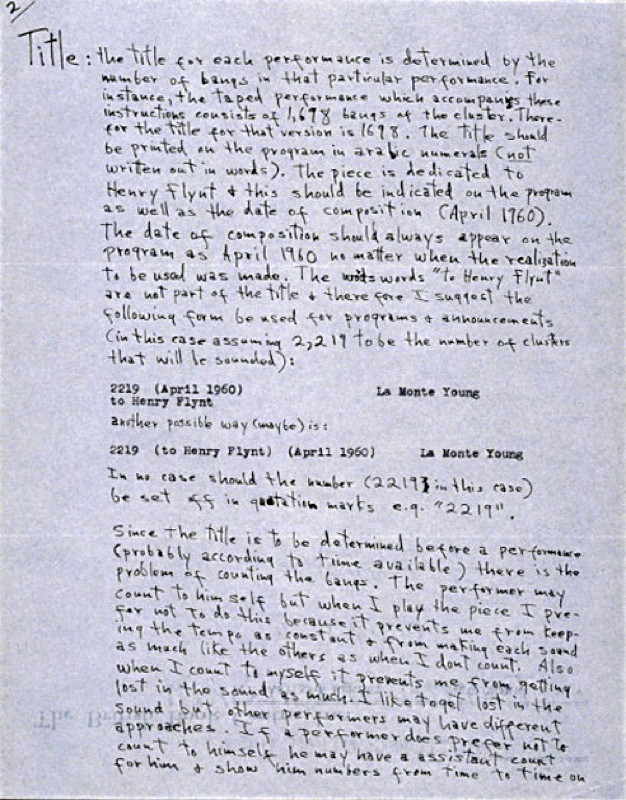 | TITLE : The title for each performance is determined by the number of bangs in that particular performance. For instance, the taped performance which accompanies these instructions consists of 1698 bands of the cluster. Therefor the title for that version is 1698. The title should be printed on the program in arabic numerals (not written out in words). The piece is dedicated to Henry Flynt & this should be indicated on the program as well as the date of composition (April 1960). The date of composition should always appear on the program as April 1960 no matter when the realisation to be used was made. The words "To Henry Flynt" are not part of the title & therefore I suggest the following form be used for programs and announcements (in this case assuming 2219 to be the number of clusters that will be sounded) : 2219 (April 1960) to Henry Flynt La Monte Young. Another possible way (maybe) is : 2219 (to Henry Flynt) (April 1960) La Monte Young In no case the number (2219 in this case) be set in quotation marks e.g. "2219". Since the title is to be determined before a performance (probabily according to time available) there is the problem of counting the bangs. The performer may count to himself but when I play the piece I prefer not to do this because it prevents me from keeping the tempo as constant & from making each sound as much like the others as when I count to myself it prevents me from getting lost in the sound as much I like to get lost in the sound but other performers may have different approaches. If a performer does prefer not to cound to himself he may have a assistant count for him & show him numbers from time to time on |
Performances(Edit)
| — 1961/05/14 — May 14, 1961. New York, "Carnegie Recital Hall". Toshi Ichiyanagi performed "Winter Music"; Christian Wolff, "For Prepared Piano"; La Monte Young, "566 to Henry Flynt"; Earle Brown, "from Folio"; Toshi Ichiyanagi, "Music for Piano #4" and "Music for Piano # 6"; Stefan Wolpe, "Form"; music by Richard Maxfield; Feldman, "Piano Piece 1952". — http://cagecomp.home.xs4all.nl/1912-1971.htm | |||||||||||||||||||||||||
 | Letter John Cage to David Tudor, typewritten, May 31, 1961, In "John Cage and David Tudor: Correspondence on Interpretation and Performance", Martin Iddon, Cambridge University Press, 2013 |
| — 1961/06/04 — " Chambers Street series ", Carnegie Hall, New York. La Monte Young’s "556 for Henry Flynt" performed with Toshi Ichiyanagi. |
| — 1961/06/16 — Prior to June 16, 1961. Paris, "Club d’Essai de la R.T.F" (Radio Télévision Française). David Tudor performed La Monte Young, "343 for Henry Flynt"; Toshi Ichiyanagi, "Music for Piano No. 4", and unknown compositions by Cage (Samuel, Claude, 1961. “Hellzapoppin du piano.” Paris-Presse (June 16).). — http://cagecomp.home.xs4all.nl/1912-1971.htm |
| — 1961/07 — "?", Paris? . La Monte Young’s "1698 for Henry Flynt" performed with Cornelius Cardew. | |||||||||||||||||||
| (Branden W. Joseph, "Andy Warhol's Sleep : The Play of Repetition", In "Masterpieces of Modernist Cinema", edited by Ted Perry, Indiana UNiversity Press, 2006, p. 194) |
| — 1961/? — "?", London. La Monte Young’s "42 for Henry Flynt" performed with Cornelius Cardew. | |||||||||||||||||||
| Cornelius Cardew performed Lamonte Young’s "42 for Henry Flynt" and Susan Bradshaw interrupted the performance by dragging him away from the piano. — (unknown reference) | |||||||||||||||||||
| At a concert in London, Cornelius Cardew gave what was probably the British premiere of a "work" by the American composer LaMonte Young, called 42 for Henry Flynt. In this piece a single sound is repeated. The title varies according to the number of repetitions. Cardew, playing the piano, perpetrated a version called 292 for Henry Flynt, where the chosen sound was created by crashing the whole forearm down on the keyboard. As the crashes continued relentlessly, a slight female figure (Susan Bradshaw) in the front row could bear it no longer. To the applause of the audience, she sprang on to the platform and physically dragged her old fellow student away from the instrument. — (Gerard McBurney, "Susan Bradshaw, Pianist, champion of modern music and 'conscience of composers'", In The Independant, Tuesday 01 February 2005 — http://www.independent.co.uk/news/obituaries/susan-bradshaw-6153451.html |
| — 1961/09/06 — "Darmstadt". David Tudor performed La Monte Young, "566 for Henry Flynt" http://music.ucsc.edu/sites/default/files/TudorInDarmstadt.pdf | |||||||||||||||||||
| "For Young’s piece "For Henry Flynt" (1960), Tudor sat cross-legged on the floor and hit a gong 566 times with a stick at the rate of about one per second. This action allegedly drove someone to call an ambulance. An emergency squad came, observed the bizarre performance situation, and departed, understandably bewildered. According to an eyewitness, Tudor just kept playing." — (Dieter Schnebel, interview, 4 February 1998, by Amy C. Beal, "Tudor in Darmstadt", In Contemporary Music Review, 26 : 1, 77-88, 2007) |
| — 1962/02/07 — "University of Colorado", Boulder, Colorado. La Monte Young’s "556 for Henry Flynt" performed with David Tudor. | |||||||||||||||||||
| February 7-8, 1962. Boulder, Colorado, University of Colorado. Performed with David Tudor: five compositions, among which Cartridge Music and presumably La Monte Young, "[Integer to Henry Flynt] (February 7, UMC Forum Room); "Where Are We Going? And What Are We Doing?" (Cage, with tapes, February 8, presumably canceled); Tudor performed "Variations II" (piano with electronics); Bo Nilsson, "Bewegungen, Schlagfiguren, and Quantitäten"; Hans Otte, "Tropismen" (February 8, morning, College of Music) (Colorado Daily 1962; Dunn 1962, 29, 34, 43; Page, A. 1962). http://cagecomp.home.xs4all.nl/1912-1971.htm |
| — 1962/02/09 — "ONCE Festival", Ann Arbor, Michigan. La Monte Young’s "923 for Henry Flynt" performed with La Monte Young. http://ronsen.org/monkminkpinkpunk/17/krumm.html | |||||||||||||||||||||||||
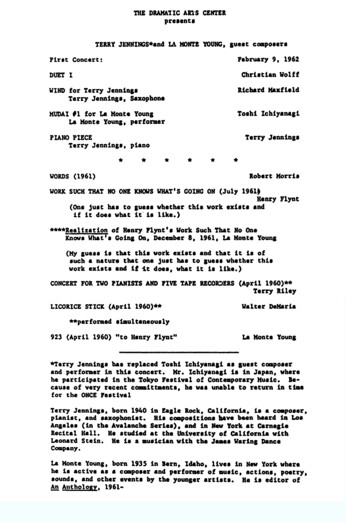 | |||||||||||||||||||||||||
 | Source : George Maciunas, "Diagram of Historical Development of Fluxus and Other 4 Dimentional, Aural, Optic, Olfactory, Epithelial and Tactile Art Forms", (Incomplete), annotated by Alison Knowles, 1973 (The Gilbert and Lila Silverman Fluxus Collection Archives in The Museum of Modern Art Archives) — more info George Maciunas |
| — 1962/09/01 — Wiesbaden, Hörsaal des Städtischen Museums, "Fluxus Internationale Festspiele Neuster Musik", Sept. 1 : La Monte Young’s "556 for Henry Flynt" performed with J. G. Fritsch and others. |
 | Source : George Maciunas, "Diagram of Historical Development of Fluxus and Other 4 Dimentional, Aural, Optic, Olfactory, Epithelial and Tactile Art Forms", (Incomplete), annotated by Alison Knowles, 1973 (The Gilbert and Lila Silverman Fluxus Collection Archives in The Museum of Modern Art Archives) — more info George Maciunas |
| — 1962/11/28 — Nicolai Kirke Copenhagen, "FESTUM FLUXORUM", La Monte Young’s "556 for Henry Flynt" performed with ?. | |||||||||||||||||||
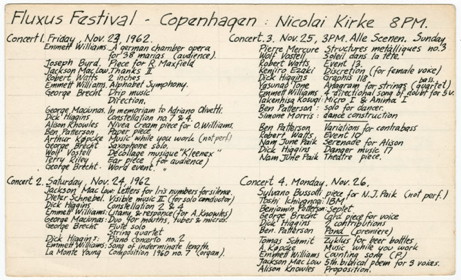 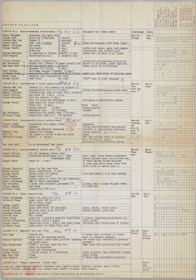 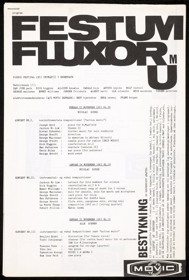 |
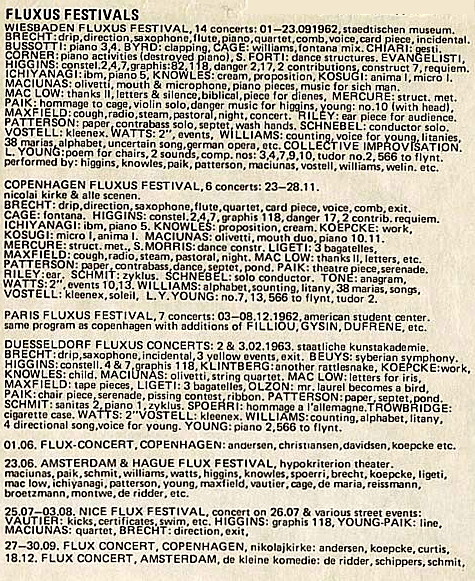 | Source : George Maciunas, "Diagram of Historical Development of Fluxus and Other 4 Dimentional, Aural, Optic, Olfactory, Epithelial and Tactile Art Forms", (Incomplete), annotated by Alison Knowles, 1973 (The Gilbert and Lila Silverman Fluxus Collection Archives in The Museum of Modern Art Archives) — more info George Maciunas |
| — 1962/12/07 — American Center Paris, "FESTUM FLUXORUM. FLUXUS. Poésie, Musique et Antimusique Événementielle et Concrète", La Monte Young’s "556 for Henry Flynt" performed with ?. | |||||||||||||||||||
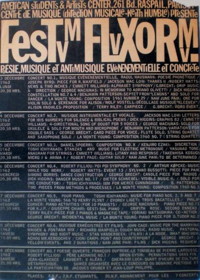 |
| — 1963/05/11 & 12 — "Yam Festival", at the Hardware Poet's Playhouse, 115 West 54th Street, New York |
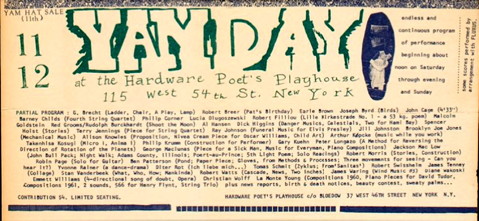 | Endless and continuous program of performance beginning about noon on Saturday through evening and Sunday Source : Walker Art Center Collection, — http://www.walkerart.org/collections/artworks/yam-festival-calendar — http://www.walkerart.org/collections?order=asc&order_by=Date+Acquired&type=Other+%2F+Miscellaneous — [more info Yam Festival (Tree by Allan Kaprow featuring La Monte Young, May 19 1963)] |
| — 1964/07/06 — "Flux Concert — a little festival of new music, Univ. of London, Goldsmiths College". La Monte Young’s "? for Henry Flynt" performed with John Cale. | |||||||||||||||||||
| It is well known that Cale studied music at Goldsmiths in the early 1960s before heading to New York and forming the Velvet Underground. According to his autobiography, he was voted ‘most hateful student’ by college heads of department and caused a minor scandal at an end of year concert in 1963 by playing avant-garde pieces of music such as La Monte Young’s ‘X for Henry Flint’ accompanied by the radical composer Cornelius Cardew and a rowdy audience. — (unknown reference) |
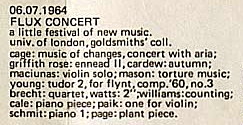 | Source : George Maciunas, "Diagram of Historical Development of Fluxus and Other 4 Dimentional, Aural, Optic, Olfactory, Epithelial and Tactile Art Forms", (Incomplete), annotated by Alison Knowles, 1973 (The Gilbert and Lila Silverman Fluxus Collection Archives in The Museum of Modern Art Archives) — more info George Maciunas |
| — 1963/02/03 — Staatlichen Kunstakademie Düsseldorf, "FESTUM FLUXORUM. FLUXUS. Musik und Antimusik. Das Instrumentale Theater", La Monte Young’s "556 for Henry Flynt" performed with Dick Higgins. | |||||||||||||||||||
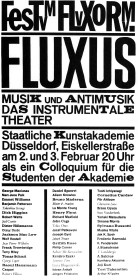  |
| — 1964 — Tokyo, Sogetsu Kaikan Hall, Nam June Paik: Composition, May 29. Prelude in e flat major, Hommage á John Cage: Musik für Tonbänder und Klavier; Étude for Pianoforte; Simple; La Monte Young’s "566 for Henry Flynt" performed with Genpei Akasegawa, Anthony Cox, Jet Curtis, Tatsumi Hijikata, Toshi Ichiyanagi, Tatus Izumi, Tomoemon Kazekura, Takehisa Kosugi, Natsuyuki Nakanishi, Yoko Ono, Chieko Shipmi, Jiro Takamatsu, Myorin Takeda, and Yasuhisa Tone. |
| — 1965 — Third Annual Festival of the Avant Garde in San Francisco; La Monte Young’s "42 for Henry Flynt" performed by Peter Winkler (gong) . http://archive.org/details/42forHenryFlynt — http://o-art.org/history/50s%26_60s/TapeCenter/_60sAvant.html |
Interprétations(Edit)
Performed by Aljaž Zupančič — Winter 2011
Piano (build in 1906 by Richard Schmutz in Vienna)
Electric guitar (build in 2004 by Gibson company in Nashville)
Performed by Ensemble for experimental music and theater — 27 jan 2012
Tokyo Wonder Site Shibuya, Tokyo
Midori Kubota, Satoko Kono, Masuhisa Nakamura, Takuma Nishihama, Takuya Watanabe, Tomoko Hojo, Tomomi Adachi.
